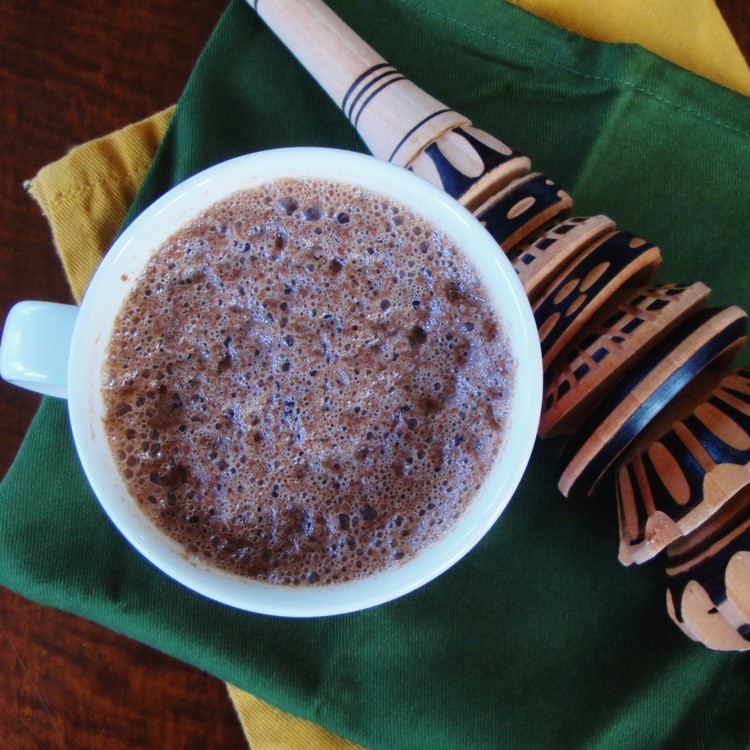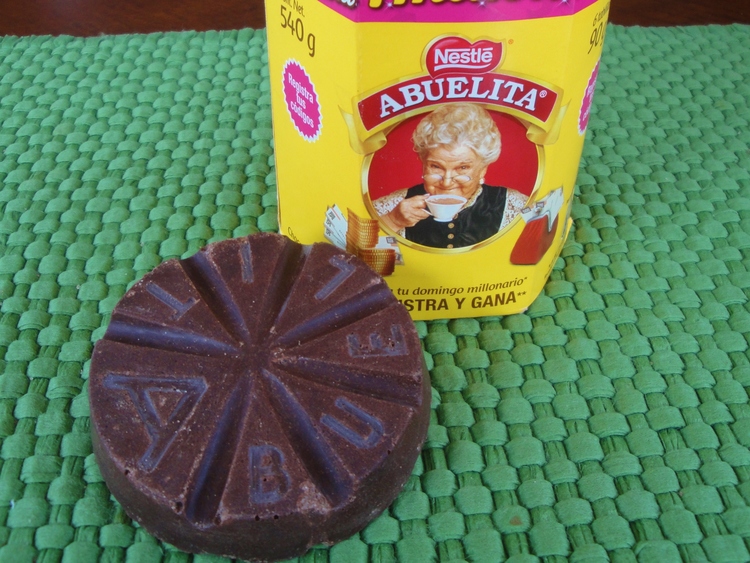How to Make Mexican Hot Chocolate
Lynley Jones
How to up your hot cocoa game with Mexican hot chocolate. Recipes, ingredients, shopping tips, how-tos and more.
A frothy cup of Mexican hot chocolate, along with my molinillo.
Beloved by Mexican kids and grandmothers, Mexican hot chocolate is chocolatey goodness in a cup, covered with froth and infused with equal parts cinnamon and love. And since chocolate originated in Mexico, it’s only fitting that if you really want to master making drinking chocolate, you need to know about the Mexican approach.
Here’s what you need to know:
What is Mexican Chocolate?
True Mexican hot chocolate begins with Mexican chocolate. Whereas we commonly start with unsweetened cocoa powder when making American-style hot chocolate, Mexican hot chocolate is made from a solid piece of sweetened, flavored chocolate that you could just as well nibble on as make a drink with.
These are the 3 types of Mexican chocolate commonly found in the US and evaluated in this post. From left to right: Abuelita, Taza and Ibarra. Taza is my favorite, judging purely on flavor and ingredients. However, Ibarra is a great choice if you’re looking for Mexican chocolate that is actually made in Mexico.
Mexican chocolate is sold in round disks (called tablets), with triangular markings (like pizza slices) to show you where you could break it up. It has a noticeably grainy texture because it’s processed only to the “liquor” stage, before it’s poured into the disk-shaped molds to cool and harden. Classically, it’s flavored with cinnamon and vanilla. To make the drink, this solid chocolate is broken into pieces, then just melted into a pot of hot milk.
What Mexican Chocolate Is Not
In restaurants north of the border (and all over the internet), the words “Mexican hot chocolate” usually tell you that in addition to the cinnamon, they’ve added some chiles to make the drink a bit spicy. For the record, I LOVE this, but that’s not how it’s traditionally served in Mexico. If you are ever so fortunate as to be invited to someone’s home for hot chocolate in Mexico, don’t expect anything spicy in the drink. It will more than likely be made just by melting the broken pieces of Mexican chocolate into a pot of hot milk, just as I’m describing here.
Mexican Chocolate Buying Guide
Only a few brands of Mexican chocolate are commonly found in the US (at least in my neck of the woods). Here are my observations about each:
Ibarra
Ibarra is the brand of chocolate that actually comes from Mexico that I like best.
Ibarra is made in Mexico, with fairly simple ingredients: sugar, cocoa liquor, soy lecithin and cinnamon flavor. Of the two Mexican brands commonly available in the US, I prefer Ibarra. It’s harder to find, but since the ingredients are fairly simple and straightforward, the taste is a bit cleaner. It’s a little too sweet for my palate, but if I’m looking for Mexican chocolate that’s actually made in Mexico, I’ll generally go with Ibarra if I can find it.
Abuelita
I really can’t recommend Abuelita (made by Nestle). It’s filled with artificial flavors, vegetable oil and chemical emulsifiers to compensate for its poor-quality chocolate. I find it really unpleasant to eat.
Although Abuelita is a beloved Mexican brand, it is now owned by Nestle, a Swiss company, and unfortunately, the ingredients have been considerably cheapened. The product contains artificial flavors, vegetable oil and the chemical emulsifier PGPR, all of which are commonly used by producers to compensate for poor-quality chocolate. To my palate, the overall effect is way too sweet, artificial and unsatisfying.
Taza
Although Taza is an American company, they import whole cacao beans from good-quality producers and grind them using traditional methods. I love Taza chocolates, both for eating and for making Mexican hot chocolate.
Taza is an American company out of Massachusetts. They import organic Direct Trade cacao beans and grind them up in the US to make the chocolate. Chocolate (cacao beans) is the first ingredient, and the only other ingredients are organic sugar and organic cinnamon. Although it feels a little strange to recommend an American manufacturer for Mexican chocolate, I really love Taza. It has the characteristic grainy texture of Mexican chocolate, and the flavor is clean and delicious, without being overly sweet. All that organic certification and Direct Trade sourcing means it’s pricey, but it’s the only brand I’d happily eat out of hand, as well as use to make drinking chocolate.
Taza comes in several flavors (how American of them!). They’re all tasty, but to experience the classic Mexican hot chocolate flavor, go with the one in the red wrapper labeled simply “cinnamon.” And one other note: while Ibarra and Abuelita come in a tall stack of fat disks (about 1/2-inch thick), Taza comes in small paper-wrapped pairs of thin disks, and the disks themselves are about half as thick as the other two. So to make drinking chocolate with Taza, use 2 thin disks to every 1 fat disk of the other brands.
Make Your Own?
Because good Mexican chocolate can be hard to find, and Taza can be very pricey, I created this recipe using good-quality bittersweet chocolate chips, cinnamon sticks and vanilla, specifically to deliver the classic Mexican flavor with easily obtainable ingredients. And I used melting chocolate rather than cocoa powder in order to stay true to the original approach to making the drink.
How to Make Mexican Hot Chocolate
Good froth is key to a good cup of Mexican hot chocolate.
Making Mexican hot chocolate is actually very simple; all the flavors are already present in the chocolate. As in this recipe, you just heat up a quart of milk (preferably whole), and break either one fat disk or two thin disks of chocolate into it. Stir occasionally until all the chocolate has melted into the milk, and you’re ready to froth and serve.
How to Froth Mexican Hot Chocolate
In general, whenever you’re making a hot milk-based drink, you’re going to want to top it with something to prevent a skin from forming in your cup. Here in the US, we generally opt for added sweetness in the form of marshmallows or whipped cream. But in Mexico, the preferred topping is (as on a good latte) simply froth. That froth is so prized by Mexican children that everyone clamors for it with a special chant while the drink is being frothed in the pot (you can read about that on this page for my old cooking class). Mexican grandmothers have been known to add a little egg white to the pot to fortify the froth so there will be plenty for every child’s cup.
Traditionally, the froth is made using a molinillo, a carved wooden rod with rings and indentations designed specifically to agitate the hot chocolate enough to create a froth. If you don’t have a molinillo, a wire whisk can be used in exactly the same way to create the froth. Either way, hold it vertically between your palms and spin it back and forth as you rub your palms together.
Using my wooden molinillo to froth Mexican Hot Chocolate in one of my cooking classes. If you don’t have this special Mexican tool, a wire whisk works great as well.
You might be tempted to use something like an immersion blender to froth your chocolate, but according to Mexican tradition, the spirit of the drink is in the froth, and it comes from the person who whipped it. So to give your spirit to the drink, whip it by hand. (And it’s not actually that hard.)
The more fat content your milk has, the better it will froth. So whole milk is always the best way to go for Mexican hot chocolate. A water-based drink won’t hold the froth at all. If you need to avoid lactose, I’d recommend opting for lactose-free whole milk if possible, rather than using other alternatives like soy milk, etc.
Once you’ve frothed the chocolate in the pot, ladle it into individual cups, then spoon more froth on top of each portion.
The Mexican Hot Chocolate Recipes
Below you’ll find my recipes to make the drink either using store-bought Mexican chocolate, or my “scratch” version made from chocolate chips, cinnamon and vanilla.
For a different approach, I’ve also included my recipe for Champurrado-Style Hot Chocolate. Inspired by the atole drink called champurrado, it’s sweetened with brown Mexican piloncillo sugar and infused with Ceylon cinnamon for another very Mexican flavor combination. This is the drink we serve at the Adventure Kitchen shop, often with a whipped cream topping.









A frothy cup-full of ancient ingredients and traditions, made “from scratch” in this recipe with easy-to-find ingredients from any grocery store.